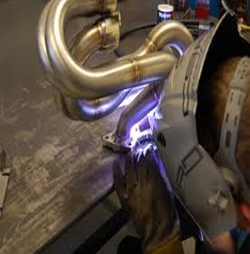PStainless steel fabrication and welding is a process that involves welding of iron-based steels known to resist corrosion using various procedures such as gas metal arc welding, gas tungsten arc welding or shielded metal arc welding. Although most of these steels have the same characteristics, such as resistance to liquids, chemicals or gases, different types of stainless steels exist.
Since fumes and gases are health hazards, always keep your head out of fumes, wear ear and eye protection or face masks. Companies should have a functional ventilation system to keep gases and fumes from the working areas.
Back to Top
Types of Stainless Steels for Welding
Different types of steels are used for stainless steel fabrication and welding. They are classified by grades, which represent the weldability and family of steel they belong.- Austenitic stainless steels – These types of stainless steels can be welded immediately using standard welding equipment. Austenitic stainless steels can also be welded using any type of electric welding process. As such, the austenitic kinds are the first option when it comes to quick welding work. The only exception is the free-machining grade 303, which is prone to cracking with heat, so they are not advised for stainless steel fabrication and welding.
- Duplex stainless steels – It has similar characteristics to the austenitic stainless steels, but only ranks second best in terms of weldability. The only advantage duplex stainless steels have over their austenitic counterpart is that they have low CTE (coefficient of thermal expansion).
- Martensitic stainless steels – These types of stainless steels can be welded but they are prone to cracking in hard or brittle zones near the weld. These problems, however, can be avoided with proper heating treatments before and after welding. Martensitics are often added to the stainless steel fabrication and welding of austenitics for added ductility.
- Ferritic stainless steels – Probably used as the last choice for welding due to their sensitization, low ductility and problematic grain growth, ferritic stainless steels are only used when heat treatments can reduce or eliminate these problems.
Stainless Steel Fabrication and Welding Processes
Several welding processes for stainless steels exist, but only the stick electrode, tig welding and mig welding are used regularly.- Stick Electrode (SMAW/Shielded Metal Arc Welding) – Uses expensive equipment for the welding process, SMAW involves heat from an electric arc and shielding from the electrode coating.
- TIG or Tungsten Inert Gas Welding (GTAW/Gas Tungsten Arc Welding) – GTAW involves heat from an electric arc and shielding from the inert gas. It can be used in various metals, without or with less post-welding finishing. They are used best for thin stainless steels.
- GMAW or Gas Metal Arc Welding – It is an automatic welding process that involves continuous feeding of shielding gas and wire electrode through a welding gun. It may also be called by GMAW’s subtypes – metal active gas (MAG) welding and metal inert gas (MIG) welding. It is one of the stainless steel fabrication and welding processes that requires quick welding time.
Safety Precautions when Handling Stainless Steel
Welding can be a dangerous craft due to the materials used and equipment that require certain skill sets. To protect yourself and other people in the workplace, make sure to read manufacturer’s instructions, be updated with the company’s safety policies, and understand the Material Safety Data Sheets before handling equipment.Since fumes and gases are health hazards, always keep your head out of fumes, wear ear and eye protection or face masks. Companies should have a functional ventilation system to keep gases and fumes from the working areas.
Back to Top
Fabrication and Welding

Fabrication and Welding Resources
- Home
- Custom Fabrication and Welding
- Fabrication and Welding Apprenticeships
- Fabrication and Welding Books
- Fabrication and Welding Companies
- Fabrication and Welding Courses
- Fabrication and Welding Engineering
- Fabrication and Welding Jobs
- Fabrication and Welding Schools
- Metal Fabrication and Welding
- Plastic Fabrication and Welding
- Precision Fabrication and Welding
- Stainless Steel Fabrication and Welding
- What is Welding and Fabrication
Sponsored Links
